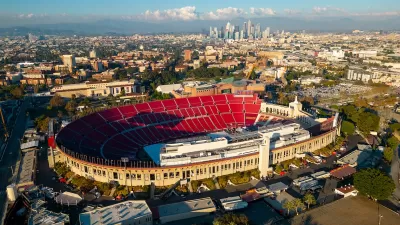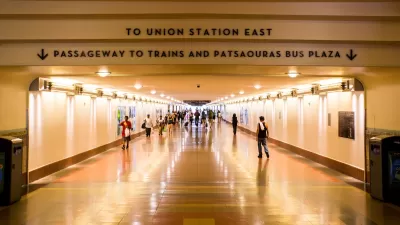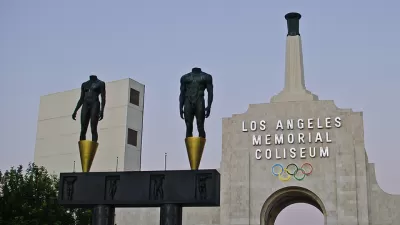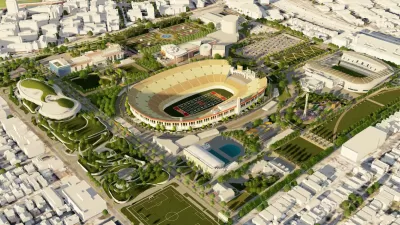Can the city fund its ambitious plans to build over $3 billion of public transit and sustainable transportation projects before the 2028 Olympic Games?

The promise of a “car-free” 2028 Los Angeles Olympics could be slipping away as a $3.3-billion wish list of transportation projects remains almost 95 percent unfunded.
As Rachel Uranga explains in Governing, “Local officials have a litany of projects they want to complete ahead of 2028, from adding charging infrastructure to improving Metro stations close to venues, but so far attempts to secure federal funds have been hit-and-miss.”
With four years to go until the event, only 34 of the 50 Olympic venues have been confirmed. Due to federal security regulations, there will be no parking immediately near most venues.
Unlike in Paris, where the city’s subway system shuttled most Olympics-goers to their destinations, “The workhorse of the L.A. Olympics will likely be buses.” According to Metro, “There will be additional bus shuttles, bus lanes and other key projects and upgrades to make the Games easy on visitors and residents.”
But the short-staffed agency will need to hire more operators and increase service frequency to effectively move the millions of visitors expected for the Games, plus the commuters and residents who regularly rely on transit. A lack of fast and convenient transit to Olympic venues could also lead to a flood of ridesharing vehicles creating more traffic and congestion.
FULL STORY: Does L.A. Have Enough Time, Money to Host a ‘Car Free’ Olympics?

Planetizen Federal Action Tracker
A weekly monitor of how Trump’s orders and actions are impacting planners and planning in America.

DARTSpace Platform Streamlines Dallas TOD Application Process
The Dallas transit agency hopes a shorter permitting timeline will boost transit-oriented development around rail stations.

Congressman Proposes Bill to Rename DC Metro “Trump Train”
The Make Autorail Great Again Act would withhold federal funding to the system until the Washington Metropolitan Area Transit Authority (WMATA), rebrands as the Washington Metropolitan Authority for Greater Access (WMAGA).

Supreme Court Ruling in Pipeline Case Guts Federal Environmental Law
The decision limits the scope of a federal law that mandates extensive environmental impact reviews of energy, infrastructure, and transportation projects.

Texas State Bills to Defund Dallas Transit Die
DART would have seen a 30% service cut, $230M annual losses had the bills survived.

Bikeshare for the Win: Team Pedals to London Cricket Match, Beats Rivals Stuck in Traffic
While their opponents sat in gridlock, England's national cricket team hopped Lime bikes, riding to a 3-0 victory.
Urban Design for Planners 1: Software Tools
This six-course series explores essential urban design concepts using open source software and equips planners with the tools they need to participate fully in the urban design process.
Planning for Universal Design
Learn the tools for implementing Universal Design in planning regulations.
City of Mt Shasta
City of Camden Redevelopment Agency
City of Astoria
Transportation Research & Education Center (TREC) at Portland State University
US High Speed Rail Association
City of Camden Redevelopment Agency
Municipality of Princeton (NJ)





























